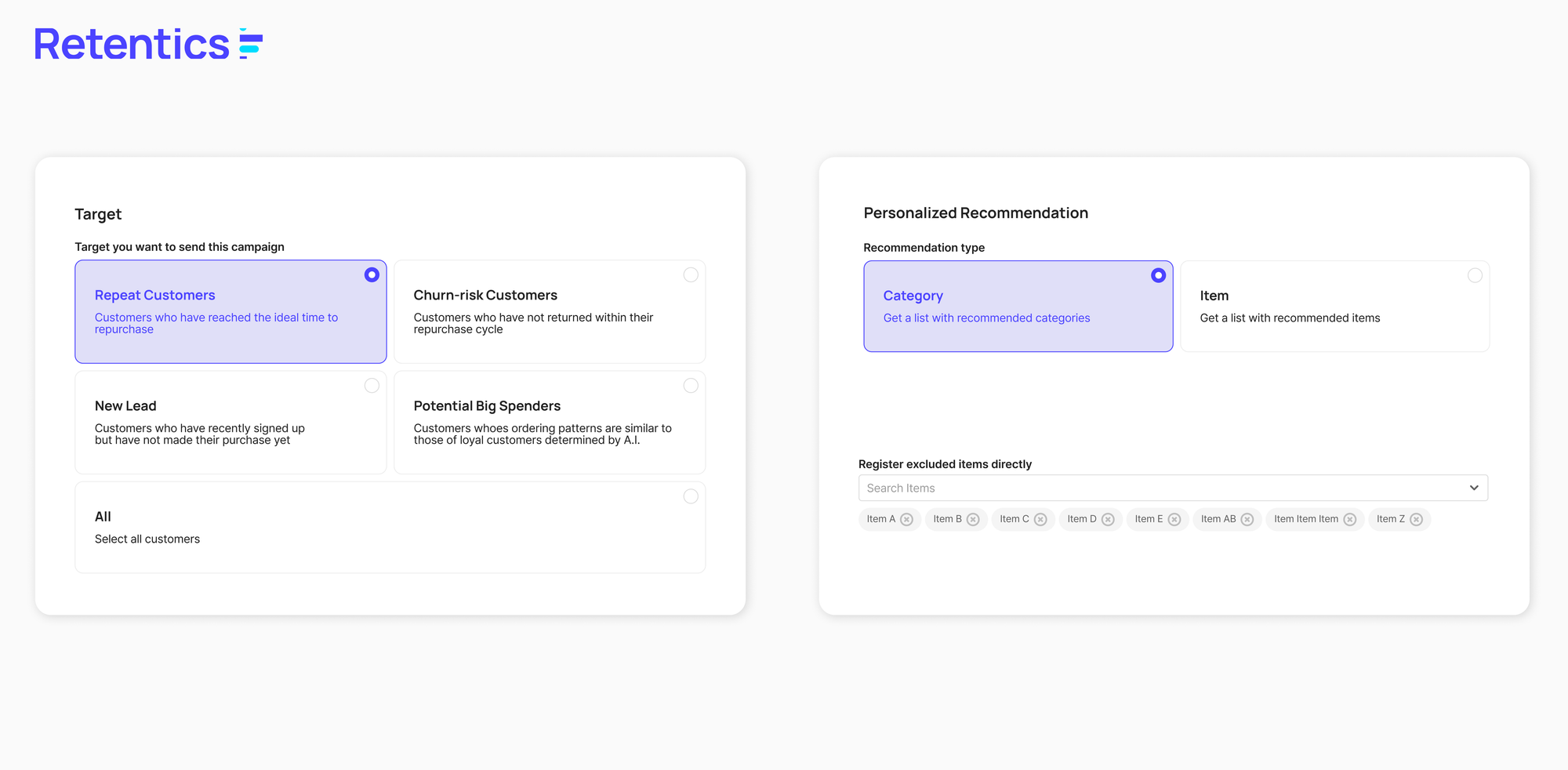What is an Email marketing & best examples of e-commerce
Don't lose your customers to competitors. It will help you do most effective email marketing strategies!
Sep 18, 2023
Contents
1. What is an email campaign?1-1. The core purpose of email campaign in E-commerce?1-2. Benefits of Email Campaigns for E-commerce Businesses2. The Best Email Marketing Campaign Examples top 152-1. Traffic Email Marketing2-2. Awareness Email Marketing3. Lead Nurturing Email Marketing4. Revenue Email Marketing3. How to create email marketing campaign3-1. Define the purpose and objective metrics of email marketing3-2. Identify the Target and the Relevant Content3-3. Implementing Follow-Up Measures3-4. Conducting A/B Testing3-5. Calculating the ROI of Each Campaign1. What is an email campaign?
An email campaign is a strategic, organized plan where marketers send out mass emails to deliver targeted messages to customers with the aim of eliciting specific actions. This method has been used in marketing for a long time and is still one of the most effective ways to communicate directly with customers. It's a cost-effective strategy compared to other communication channels in E-commerce business, as it requires fewer resources.
Email campaigns allow for the efficient building of relationships with target customers through consistent communication. By applying personalized marketing strategies, businesses can effectively drive customer purchases. Essentially, an email campaign is a form of email marketing that enables e-commerce companies to communicate directly with their customers, enhance brand visibility, boost customer engagement and ultimately increase sales.
When considering Customer Relationship Management (CRM) marketing strategies, people often think about text messages or app notifications. However, compared to other CRM tools like these, email campaigns are not only more affordable but also more effective as they allow for high freedom in design and form. This enables marketers to create diverse content formats that suit their purpose and resonate well with their audience.
1-1. The core purpose of email campaign in E-commerce?
In various situations where businesses need to communicate with customers, email marketing serves as an indispensable channel. Many e-commerce companies are already utilizing email marketing for diverse purposes such as promotional advertising or providing updates about the company's itemss or services.
In today's digital age where consumers receive hundreds of advertising emails from numerous e-commerce companies every day, it becomes crucially important for businesses to clearly define "why" they are sending emails to their customers. The content should be appropriately structured according to its intended purpose.
a) Increasing Revenue Through Close Relationships with Customers
In various situations where businesses need to communicate with customers, email marketing serves as an indispensable channel. Many e-commerce companies are already utilizing email marketing for diverse purposes such as promotional advertising or providing updates about the company's items or services.
In today's digital age where consumers receive hundreds of advertising emails from numerous e-commerce companies every day, it becomes crucially important for businesses to clearly define "why" they are sending emails to their customers. The content should be appropriately structured according to its intended purpose.
One main purpose is increasing revenue through close relationships with customers. All e-commerce platforms send promotional emails targeting active or inactive (or churned) ones aiming at sparking interest or maintaining customer retention. These emails contain direct promotions of the company's items and services such as update news and event information aimed at maximizing sales.
Recently in e-commerce landscape automated email marketing has gained popularity because it facilitates communication that drives purchase conversion according to each customer's situation following Acquisition > Activation > Revenue [AARRR funnel]. Furthermore personalized emails are sent using customer names tag and behavior patterns which enhances engagement levels significantly.
For instance multiple leading email sending tools like Mailchimp Klaviyo etc., provide functions that can automatically send emails by setting specific triggers - 'welcome' mail sent immediately after a new lead registers 'viewed item discount promotion' mail sent when a customer recently viewed certain item etc!
Given today’s competitive environment where consumers have already been exposed widely these types of messages it becomes essential for us not just send personalized messages based on simple metrics like search history visit records but rather offer advanced personalization recommendations including sending an email recommending Item B if our transaction data shows that those who bought item A tend also buy item B next!
b) Securing Potential Leads Who Align with Brand Value
Beyond the scope of promotional emails, there's another crucial facet to email campaigns - newsletters. Newsletters serve as a platform to deliver useful information that can attract potential leads who might eventually become our customers and even encourage their purchases. This strategy is not just about selling; it's about sharing knowledge, insights, and stories that resonate with your audience on a deeper level.
Regularly sending newsletters plays an integral role in strengthening the area of branding. It allows businesses to consistently communicate their brand values, vision, and mission. This regular communication helps in building a community of subscribers who share the same values as your brand.
Subscribers are more than just potential customers; they're individuals who have shown interest strong enough to opt into receiving regular updates from your business directly in their inbox. They are individuals who have expressed an initial trust in your brand and are open to hearing more about what you offer.
Therefore, the newsletter acts as an incredibly effective marketing channel that delivers detailed and concrete information about our products or services. More importantly, it provides value beyond what is being sold by sharing industry news, tips related to product usage or even inspiring stories that align with your brand message. By doing so, we're able to foster a stronger relationship with these leads and guide them along the journey from mere subscribers into actual loyal customers.
c) Driving Traffic to Specific Pages
In every email sent for marketing purposes - whether it's a promotional mail or newsletter - it is essential to include a CTA (Call To Action) button or link strategically placed within the content. The purpose of this CTA is simple yet powerful: guide readers towards taking an action you desire.
By sharing this link directed at your website or specific landing pages designed in accordance with your goals, you can drive targeted traffic effectively where you want them to go next after reading through your email content.
For instance, if you want users to learn more about a particular topic discussed in the newsletter, including links leading them directly towards relevant blog content on your website can be highly beneficial. If there's new product launch coming up soon? Share links leading readers straight into detail pages containing more information regarding these new offerings!
Moreover if there's specific campaign promotion underway consider creating separate landing page dedicated solely for it driving increased traffic onto that page through CTAs included within emails sent out during this period!
Through these strategic placements of CTAs within each email not only can businesses increase visits relevant sites but also significantly boost lead conversion rates customer engagement levels alike! It serves dual purpose - providing readers easy access desired information while simultaneously helping businesses track user behavior better understanding which aspects their campaign working best optimizing future strategies accordingly!
1-2. Benefits of Email Campaigns for E-commerce Businesses
Email campaigns are a potent tool in the arsenal of e-commerce businesses, offering the benefits that can significantly impact their growth and profitability. Let's dig into some of the key advantages:
a) Cost-Effective:
One of the primary reasons why email marketing is so popular among e-commerce businesses lies in its cost-effectiveness. Unlike traditional advertising methods that often require a substantial budget – think TV commercials or print ads – email campaigns can be executed with minimal costs.
This efficiency extends beyond just monetary savings. Email marketing allows businesses to reach a broad audience, potentially thousands or even millions of people, with just a few clicks. This widespread reach combined with low operating costs makes email campaigns an attractive option for businesses looking to maximize their marketing ROI.
b) Personalization:
In today's digital age, personalization is not just preferred; it's expected. With advancements in technology and data analysis capabilities, businesses can now personalize their emails based on individual customer behavior and preferences.
Personalization goes beyond merely including the customer's name in the email greeting (though that certainly helps). It involves crafting content that aligns with the recipient's interests, needs, and purchasing history – essentially making each communication feel like it was specifically designed for them.
This level of personalization allows for more targeted and relevant content which invariably leads to increased engagement rates. When customers receive content tailored to their needs and interests, they're more likely to engage with it by opening the email, clicking on links within it or even making a purchase.
c) Improved Customer Retention:
Customer retention is paramount in any business sector but particularly so in e-commerce where competition is fierce. Regular communication through emails helps maintain strong relationships with customers thereby improving customer retention rates significantly.
By sending personalized offers or information about new products or services regularly you keep your brand at top-of-mind awareness amongst your customers this consistent contact keeps them engaged encourages repeat purchases leading improved loyalty higher lifetime value each customer!
2. The Best Email Marketing Campaign Examples top 15
2-1. Traffic Email Marketing
Traffic email marketing is actually a broad sense that it contains welcome emails, seasonal emails, newsletters, promotional emails, cart abandonment emails and so on. In fact, most of the emails sent to customers can be considered as one type of traffic email marketing, aimed at driving traffic to their landing pages. However, here are some few examples of traffic emails where the primary goal is the 'traffic' to its landing pages.
a) Newsletter Email
A newsletter email is a type of email marketing communication that is sent regularly to subscribers, typically on a scheduled basis, such as weekly, monthly, or quarterly. Newsletter emails contain curated content, updates, news, and information about a company, brand, or organization.
Apartment Therapy #1
Apartment Therapy is a popular lifestyle and interior design website and media company. The brand encourages website visitors to subscribe to their newsletter. This is often done through pop-ups, sign-up forms at the end of articles, or dedicated landing pages. Subscribers receive regular emails with curated content and updates. Below is the example of the newsletter they provides.
They know how to drag their subscribers to their website using beautiful photos of dreamy apartments. Their compelling images draw their subscribers and encourage them to take a closer look at the articles. Apartment Therapy does a great job in presenting physical and emotional experience in their newsletter.
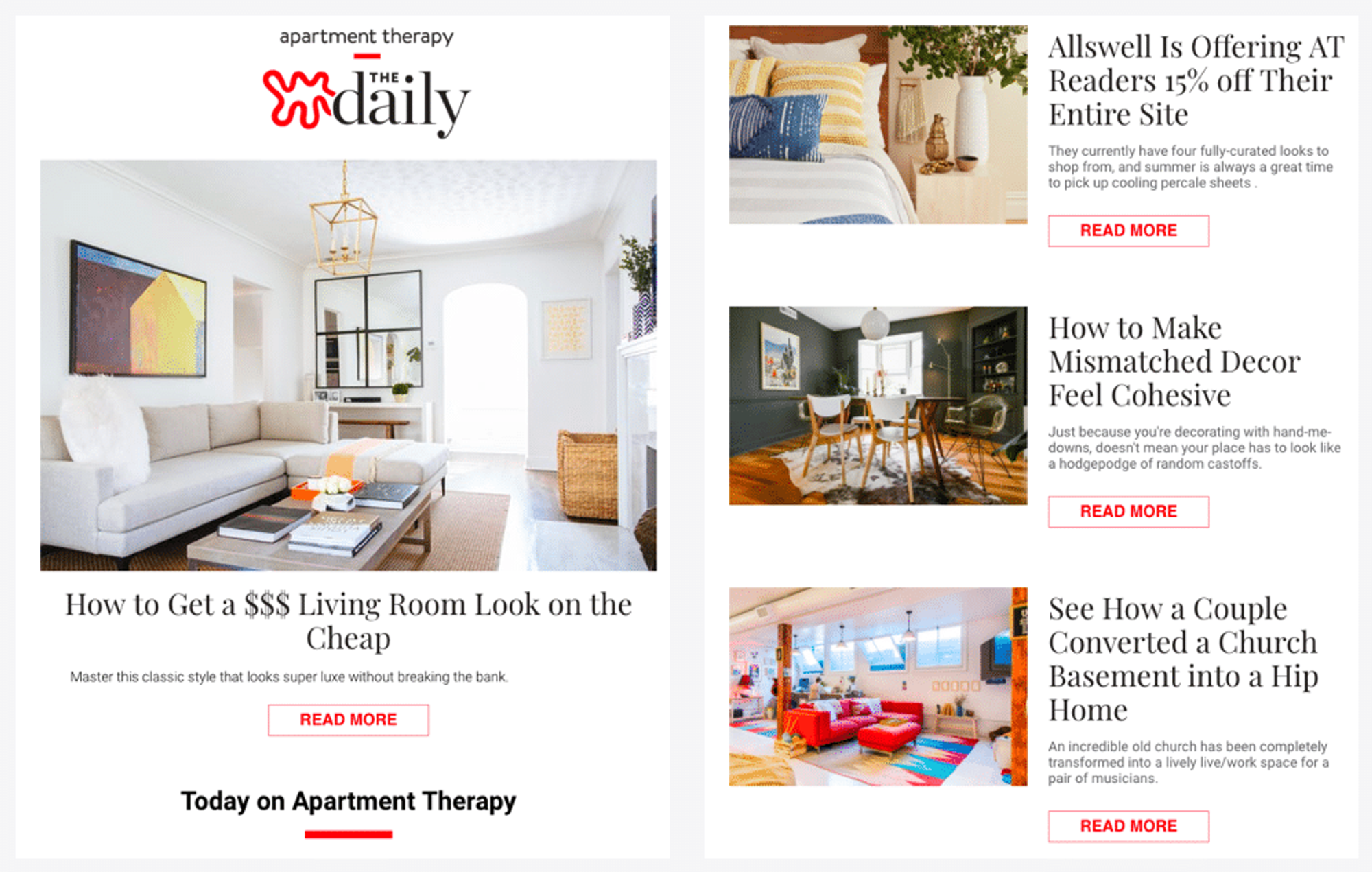
Lululemon #2
Lululemon is a well-known athletic apparel company that specializes in yoga and workout clothing and accessories. Special thing of Lululemon is that the brand freely gathers products from its website to create various collections and sends newsletters. Sometimes, they group items related to activities like running or tennis, while other times, they group products of the same color. It’s more like a digital catalog that users can enjoy. The contents also go beyond mere product introduction, providing variety of content, from workout ideas and fashion tips to customer reviews, keeping subscribers engaged.
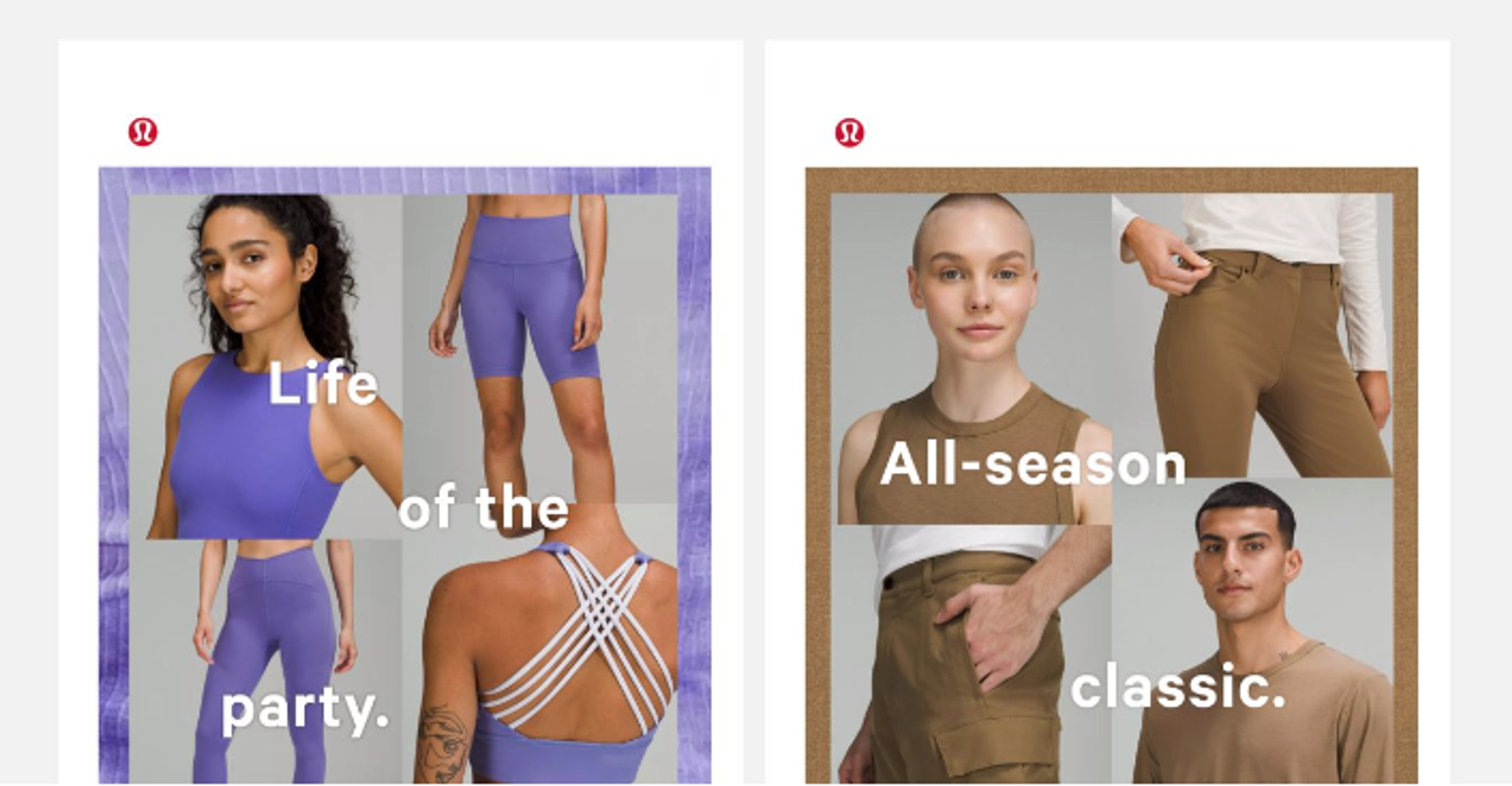
b) Personalized Email
Spotify #1
Spotify is a popular digital music streaming service that provides users with access to a vast library of music tracks, podcasts, and other audio content from around the world.
With their fan-first releases, Spotify makes users feel like they are a VIP being offered with special supply, invited to the hidden concert or getting secret messages from celebrities. By granting exclusive early access, this action raises a sense of loyalty from the top fans and a sense of reward with the opportunity to secure coveted concert tickets before the general public.
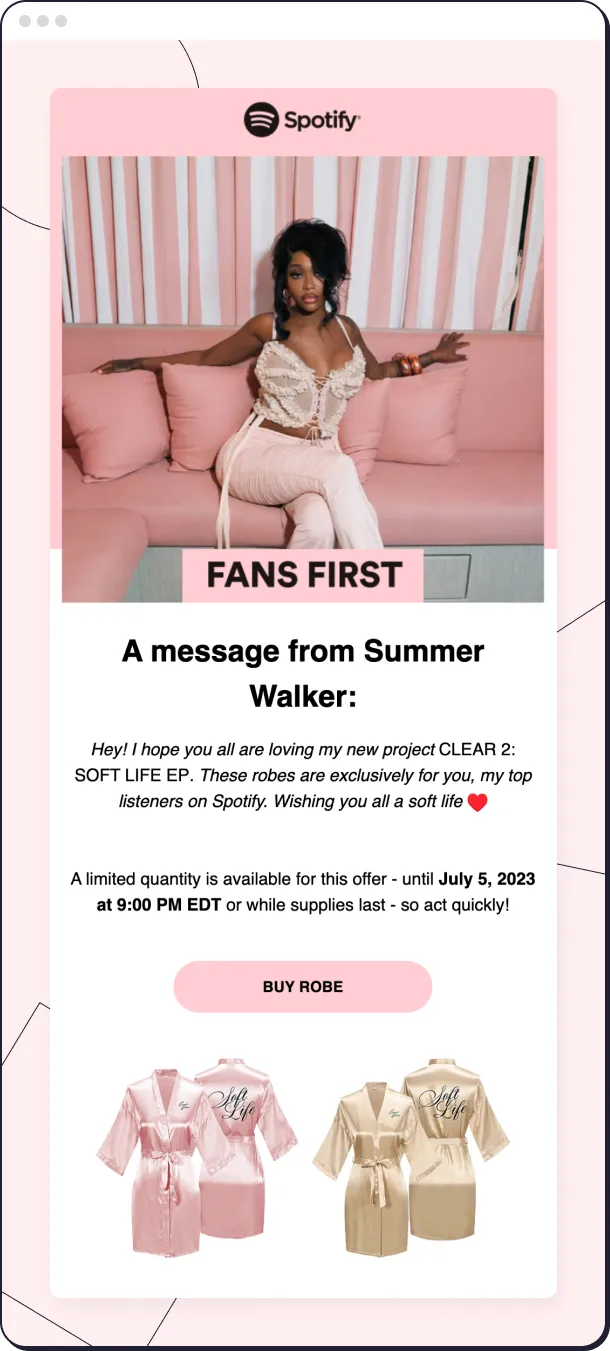
2-2. Awareness Email Marketing
a) Welcome Email
A welcome email serves as an opportunity to make a positive first impression on new subscribers or customers. It can create a favorable initial impression of the company or brand. The role of a welcome email is to help customers better understand the company or brand, pique their interest, provide information about products, services, or content, and enable customers to grasp the values associated with the brand. Therefore, the first impression of the brand through the welcome email plays a significant role in branding and can lead to long-term relationship building with customers, encouraging actions such as website visits, product purchases, event attendance, and more. Utilizing a call to action (CTA), it can also prompt customers to take desired actions, making effective use of welcome emails essential for the success of email marketing.
Pipcorn #1
Pipcorn is a snack brand that primarily sells snack products made from mini popcorn (small corn). Pipcorn strives to offer healthier and more natural snack options, providing tasty and savory choices. Pipcorn is sold in stylish packaging with various flavors and is one of the popular snack brands. Earning up to $5 million annually and being one of the top Shopify stores, how does Pipcorn send its welcome emails?
Pipcorn starts its welcome email with the phrase "Thanks for supporting family biz." to establish a personal connection with customers. It conveys a sense of tradition, care, and personal investment in the business, which can resonate with customers who value family and personal relationships. Moreover, the email conveys what subscribers can expect from the emails in clear sense. Finally, the email mentions a 15% discount code on the top and at the end of the email abovve a CTA button so that customer don’t miss their benefits.
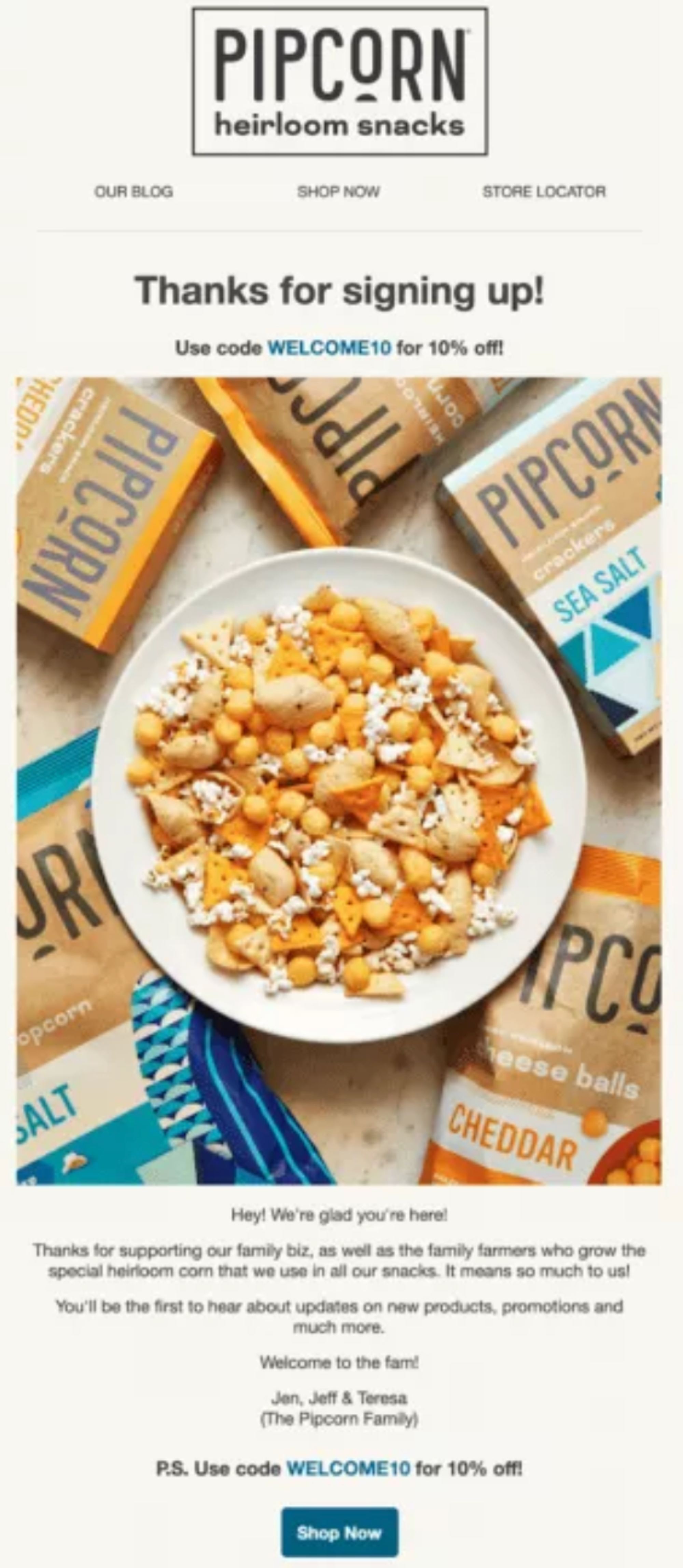
Hotjar #2
Hotjar is a popular web analytics and user feedback tool that provides website owners and developers with insights into how users interact with their websites. It offers a range of features designed to help improve the user experience and optimize website performance. Let’s take a look into how Hotjar sends their welcome mail!
If you look into their welcome email, you can easily find that the key goal of this email is to help users install the necessary script on their site. To prevent customers from getting churn even without using their service due to huddles in installing scripts and writing codes, Hotjar talks you through what you need to do. After reminding them of their username, big CTA button to install appears and a step-by-step guide follows.
b) Brand Awareness Email
Brand Awareness Email typically refers to an email marketing campaign or strategy aimed at increasing and reinforcing a brand's recognition and familiarity among its target audience. The primary goal is to make recipients more aware of the brand's existence, values, products, or services.
reMarkable #1
ReMarkable is a brand that is well-known for its digital paper tablets and related products. The company's flagship product is the "reMarkable Paper Tablet," which is designed to mimic the feel of writing or drawing on paper while offering digital note-taking capabilities.
Below is the welcome email of reMarkable but it depicts its brand so well that it also comes under the region of brand awareness. reMarkable explains the brand's journey starting in 2017 and its embrace by individuals seeking to enhance the way they work. The email then shares the benefits of the latest product and directs readers to its FAQ, to follow the brand on Instagram, or to visit the blog to read more. Sharing the brand’s mission itself gives a sense of awareness of its social profiles.

Lush #2
Lush is a British cosmetics company that specializes in creating and retailing various handmade beauty and personal care products. The company is known for its commitment to using fresh and ethically-sourced ingredients in their products, as well as their stance against animal testing.
In Lush's newsletters, you'll typically find events and curated products tailored to seasonal themes. Curated product emails help customers discover new items and align their preferences, ultimately encouraging regular purchases. Through newsletters, customers can easily explore products based on their purpose or preferences. Lush's newsletters incorporate CTA buttons with phrases like 'Experience It' or 'Bring Imagination to Life,' connecting to product detail pages to provide customers with an indirect experience. Rather than solely emphasizing purchases for higher retention, Lush's messages incorporate the brand's visual and olfactory product features and values, ensuring that customers don't perceive the newsletter merely as an advertisement.
Starbucks #3
Starbucks is a globally renowned coffeehouse chain known for its premium coffee and espresso beverages. Starbucks is known for their email marketing campaigns which often include personalized recommendations, special offers, and news about new products. Starbucks also leverages email to promote its loyalty program, which encourages repeat visits and customer engagement.
The image below is an email that links directly to the Starbucks Reserve site which contains articles relating to that product in the Starbucks ecosystem. This email shares the news of the opening of Starbucks Reserve in Milan and tells the story of Starbucks' entry into Italy, highlighting its historical significance. In other words, the newsletter goes beyond simply announcing a new store opening; it conveys the brand's attitude and mission, allowing readers to experience what the brand stands for firsthand.
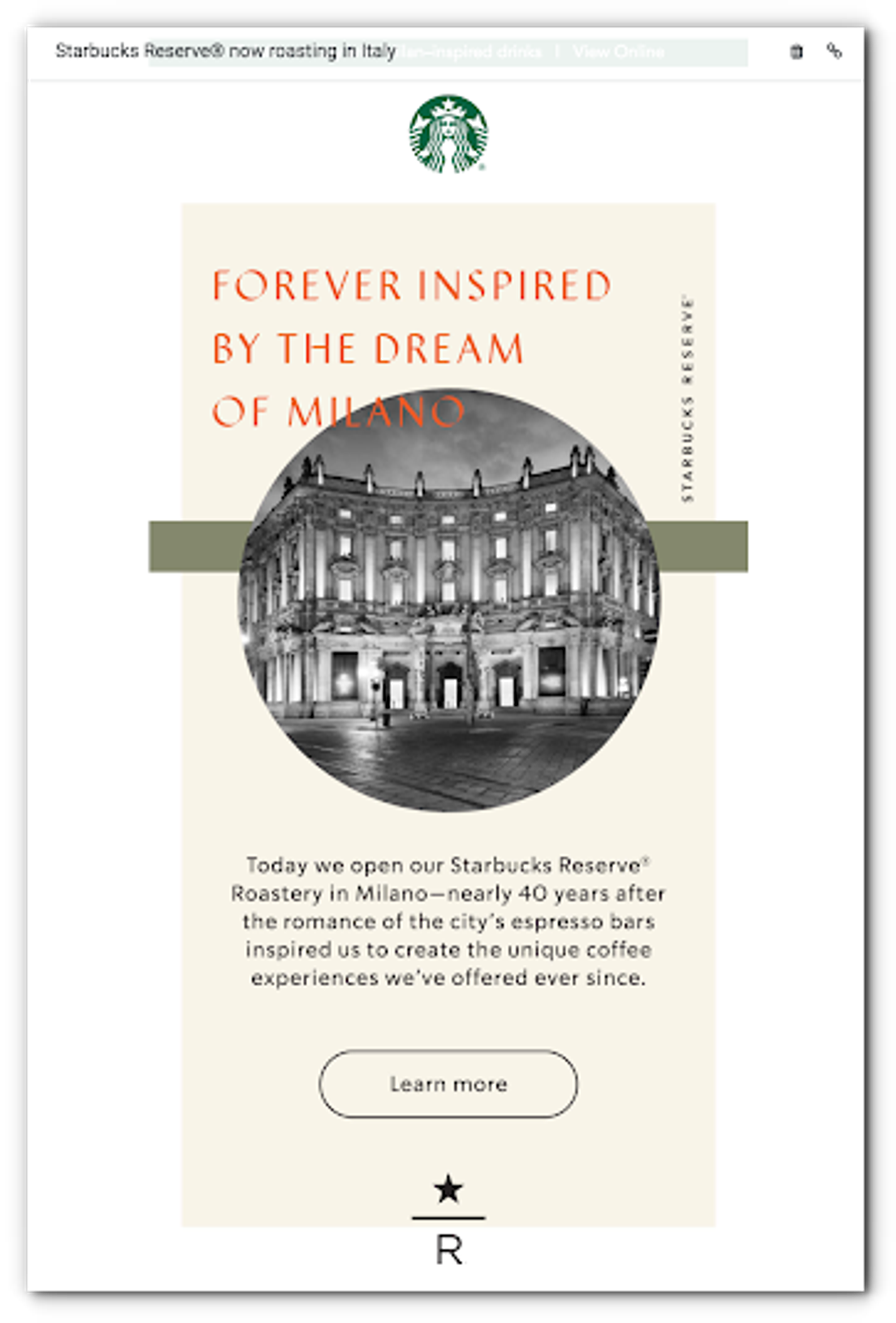
Allbirds #4
Allbirds is a footwear and apparel brand known for its sustainable and environmentally friendly approach to design and production. Allbirds is particularly famous for its sneakers, which are made from sustainable materials such as merino wool, eucalyptus tree fiber, and recycled plastic bottles.
Below is the welcome letter of Allbirds. Welcome letter also largely goes under traffic email but Allbirds welcome letter goes beyond just driving the traffic. Their letter focus more on manufacturing process producing less waste and pollution and how the shoes are being made with sustainability in mind. The email maintains its focus on nature by referencing Mother Nature, highlighting that Allbirds represents the intersection of sustainability and fashion.

3. Lead Nurturing Email Marketing
a) Educational Content Email
Educational email content is a type of email marketing material that provides recipients with valuable information, insights, or knowledge on a particular topic or subject relevant to their interests, needs, or challenges. The primary goal of educational email content is to inform and educate the audience rather than directly promote a product or service.
Framebridge #1
Framebridge is an online custom framing company that allows customers to easily frame their art, photos, and other items. The company offers a user-friendly online platform and a variety of framing options, allowing customers to choose from different frame styles, matting, and other customization features.
The brand provides educational content to nurture its customers, such as 'How to hang your art'. The email simplifies the process into three steps for hanging artwork and encourages customers to click the 'Educate Me' CTA button to learn more about each specific method. This helps to remove potential hurdles for customers and gives the impression that the brand cares not only about selling artwork but also about addressing customer concerns, ultimately leading to actual purchases.

Shopify #2
Shopify is an well-known e-commerce platform that allows individuals and businesses to create and manage their online stores. Once you sign up Shopify, you face with full package email in order to launch your store, custom domain and resources to grow your online store with video tutorials. Shopify presents effective welcome email that guides new users on various actions they can take using the software.
Stating that the user is on a free 14-day trial from receiving the email, Shopify lets users know what steps users should take next.

b) Benefit-focused Email
This type of email typically refers to an email marketing approach where the primary emphasis is on communicating the benefits or advantages of a product, service, or offer to the recipient. Instead of just listing features or providing general information, these emails aim to highlight how the recipient will benefit from what is being offered.
Paypal #1
PayPal is a widely used online payment platform that allows individuals and businesses to make financial transactions over the internet. It provides a convenient and secure way to send and receive payments, make online purchases, and transfer money between users.
Under below email marketing campaign example, Paypal encourages users to have a look on their ‘3 Reasons to check out with Paypal’ explaining key benefits out of Paypal feature. Rather than pin pointing details about the feature itself, Paypal uses simple and minimal copy to imprint their benefits.
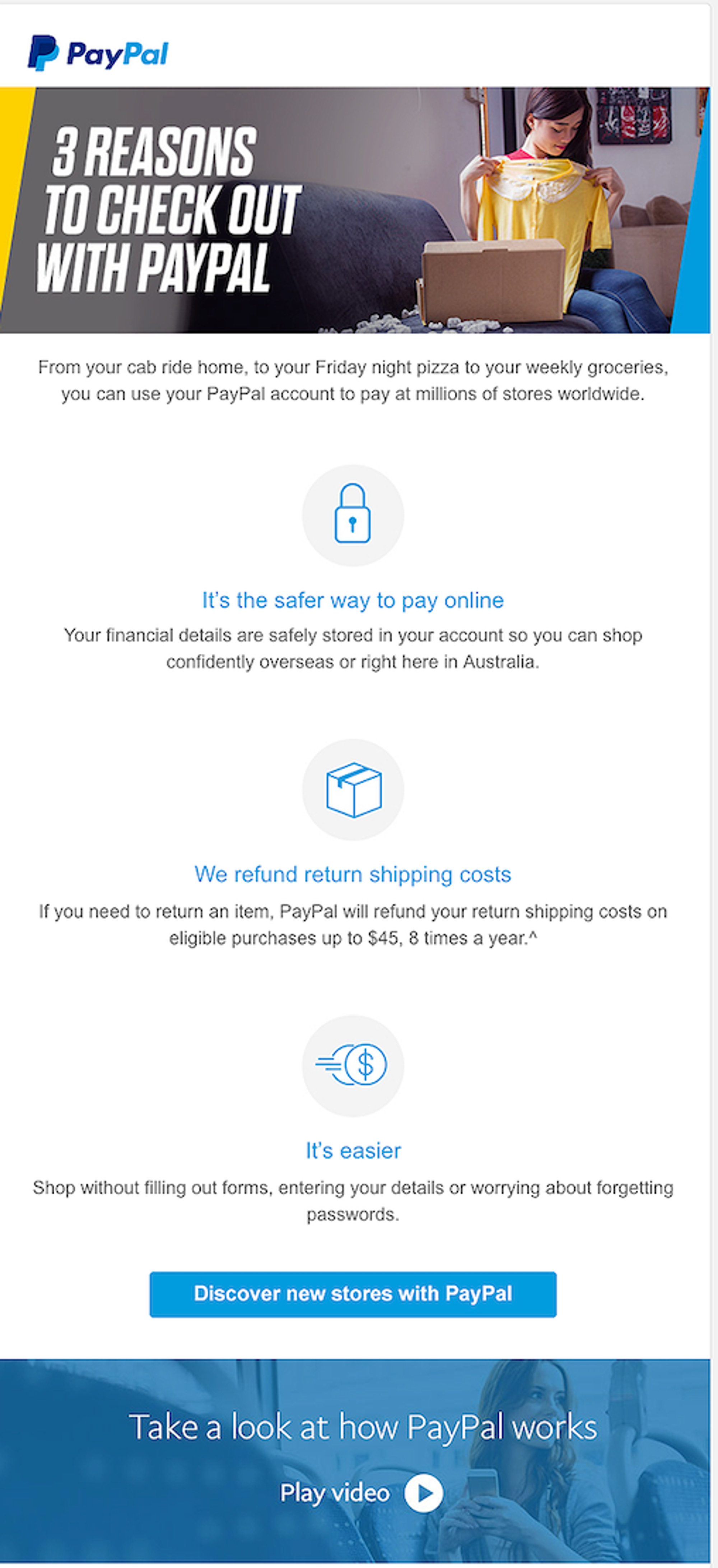
c) Purchase trigger Email
Casper #1
Casper is a well-known brand that primarily specializes in mattresses, pillows, and other sleep-related products. There are many types of abandoned cart email but Casper uses a witty copy, “Come Back To Bed” in order to drag customer to complete their purchase. Adding fun customer review under the product the customer has added to his/her cart, Casper induces customers to their landing page with two simple CTA buttons. Even with a simple copies or templates it shows that brand can effectively convey their message enough to trigger customer actions.

4. Revenue Email Marketing
a) Re-engagement Email
Re-engagement emails are important across businesses of various sizes and industries for several compelling reasons. Primarily, they serve as a powerful marketing tool that can boost recurring sales and revenue. By prompting customers to repurchase items they've previously purchased or subscribed to, businesses can enhance customer retention and loyalty, minimize churn and cart abandonment rates, and establish a steady and predictable income stream.
Urban Outfitters #1
Urban Outfitters is a well-known American multinational lifestyle retail corporation headquartered in Philadelphia, Pennsylvania. When customers request to unsubscribe, Urban Outfitters sends an automated email like the one below. Interestingly, the automated email makes unsubscribing feel like breaking up with a loved one, offering a YES/NO option, but making it difficult to actually press the unsubscribe (No) button. They creatively stage a unique scenario and touch subscribers' emotions, demonstrating an effort to maintain a longer-term relationship with customers.
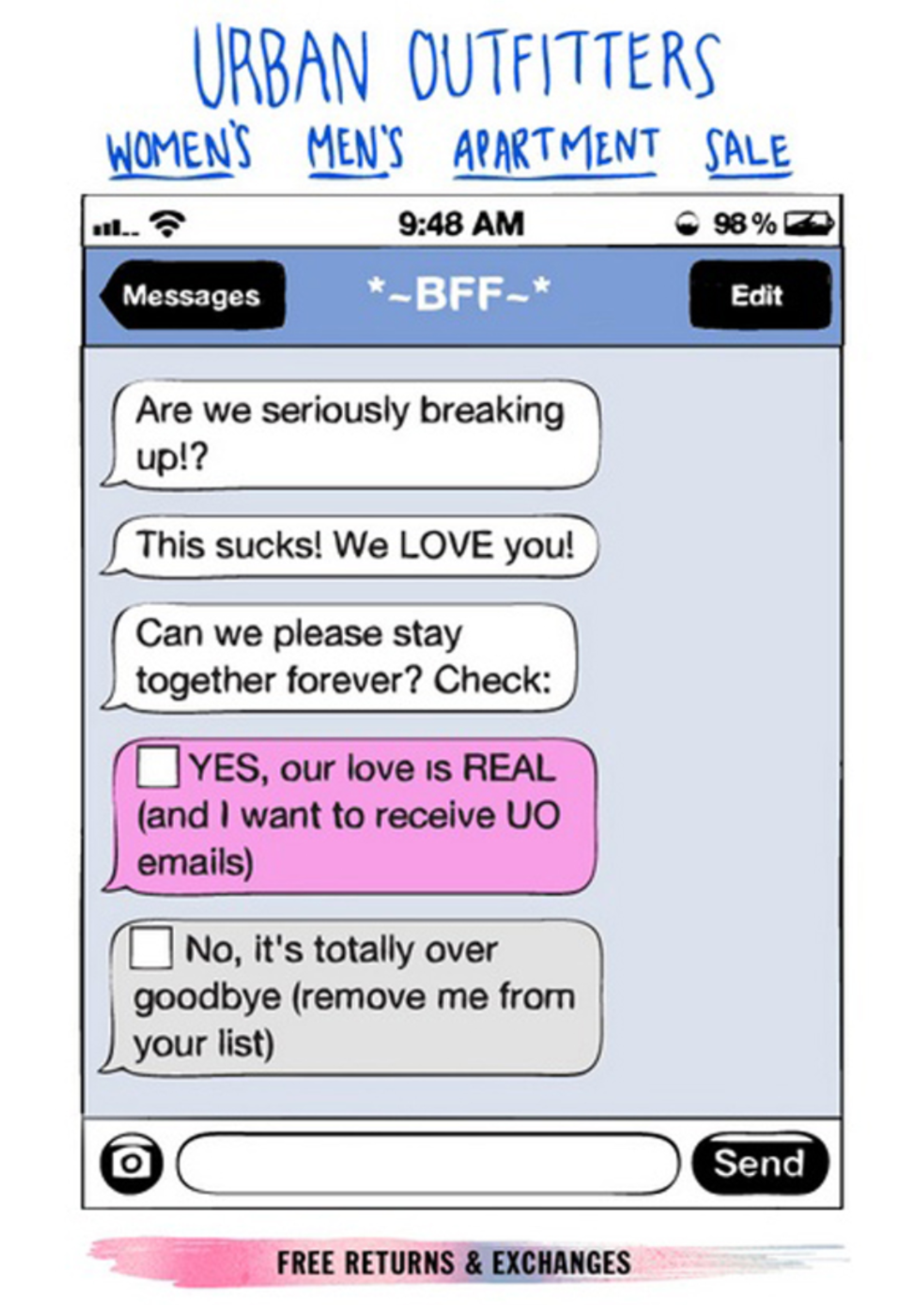
Duolingo #2
Duolingo is a language learning app with 500 million subscribers. While it's primarily free, they also operate a paid subscription program called 'Duolingo Plus.' Approximately 75% of their total revenue comes from subscription fees, highlighting the importance of user engagement for their service. Given that it's a language learning app, continuous motivation and user engagement are crucial for user retention. How does Duolingo use email to motivate its users?
Upon signing up for the service, Duolingo users receive a daily email, typically encouraging them to continue their language learning journey. These emails are automated and sent at a predetermined time each day, regardless of the user's actual learning activity. They employ engaging language in these emails, almost as if they're speaking directly to the user. For example, they might say, "Hi, Claire, learning German requires daily practice. Practice now?" or use attention-grabbing emojis and phrases like, "Duo here! Have time for some German?⏰" to motivate users and reinforce their commitment.

In addition to the daily motivational emails, Duolingo sends users a weekly progress report titled "Your weekly progress report" once a week. This report includes information on how much time the user spent learning, the number of new words and sentences they learned, and the number of completed lessons. Through these reports, users can gauge their learning progress, gain renewed motivation, and experience a sense of achievement.
b) Event & Promotional Email
Grammarly #1
Grammarly is a popular online writing tool and digital writing assistant. It helps users improve their writing by checking for spelling and grammar errors, suggesting corrections, and providing style and clarity recommendations.
On the fourth email Grammarly sends to new users, they offer upgrade pro version of their product. With clarified what is included under the plan and what isn’t, users can get a clear sense on the reason why they should go for upgrading their annual plan. They didn’t put their pricing table in the email so that it encourages more users to click through to view exact discounted amount.
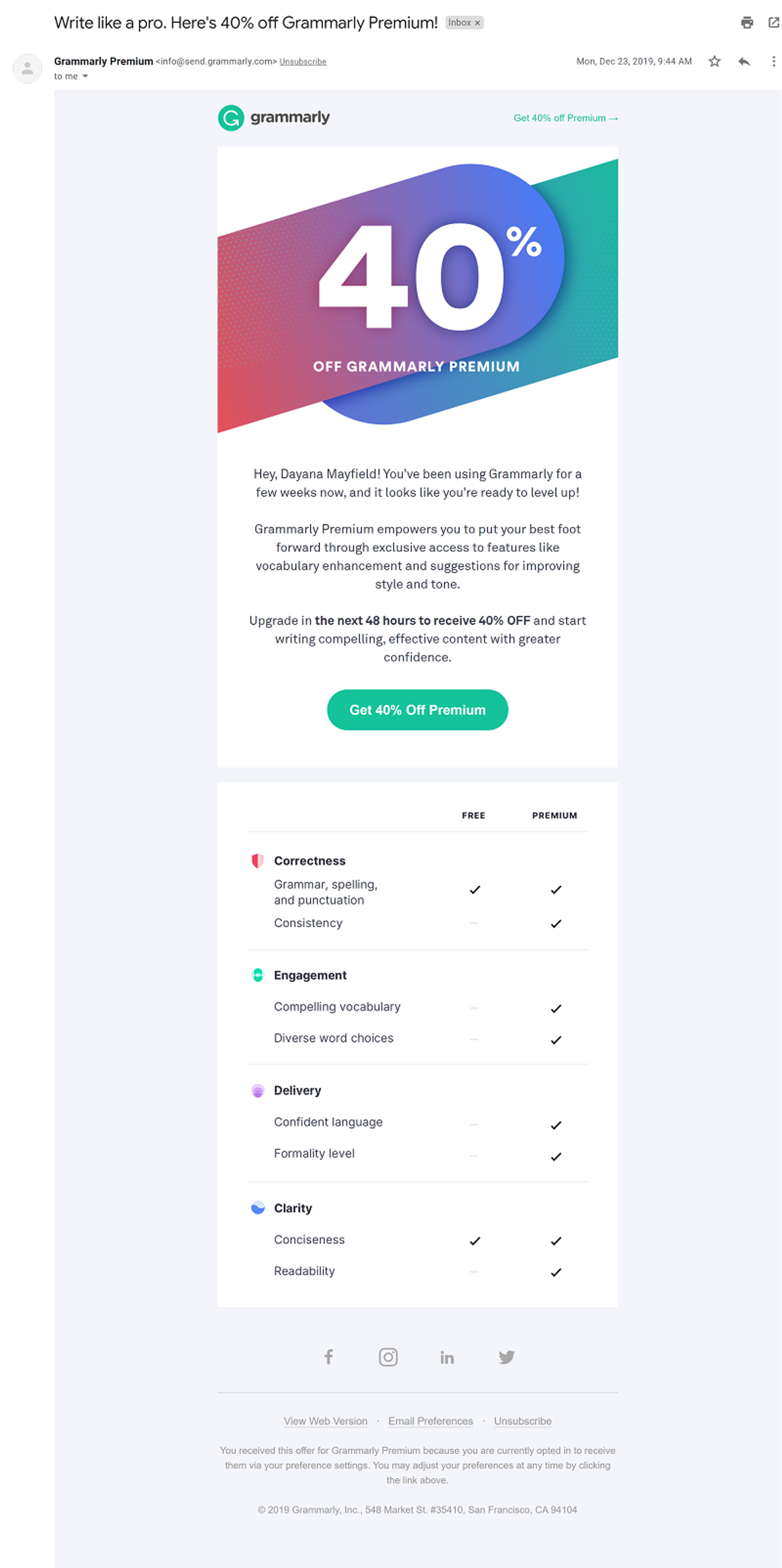
Barkbox #2
Using the seasonal speciality, brands send personalized email that involves birthday customers to acknowledge the special day, celebrate the occasion and make purchases by providing special offers. Barkbox is one of the pet brand which uses that instance very well.
BarkBox is a subscription-based service for dog owners. It provides monthly boxes filled with various dog treats, toys, and other products. On the pet’s birthday, they send an email with a copy, “We hear its a special pup’s birthday!” and offers owners to add Happy birthday pup-pie to their cart. This birthday email is fun and playful and also features products that are relevant to the reader.

3. How to create email marketing campaign
Creating an email marketing campaign requires careful planning and various considerations. Broadly, the process can be divided into two main parts: designing the visual elements of the email and determining the target audience and content for the email. In this article, we will primarily discuss how to define objectives, identify targets, and develop content for effective email marketing.
3-1. Define the purpose and objective metrics of email marketing
When creating an email marketing campaign, two of the most critical questions we need to answer are: "Who are we sending it to?" and "What content will we send?" To answer these questions effectively, it's essential to clarify the business's objectives for when customers read the email. For instance, if the goal is to induce a first-time purchase experience, our target could be individuals who have signed up but have not yet made a purchase. The content might include benefits like discount coupons to encourage that first purchase. We could also establish a timeframe, such as sending the email a few days after registration. Therefore, defining the purpose of the email is crucial for guiding all subsequent processes.
Another advantage of defining your purpose is that you can set specific objectives that will help determine the success of your campaign. Common metrics that can be tracked in email marketing include open rates (how many people open your emails), click-through rates (how many people click on embedded links in your emails), conversion rates aligning with your email's purpose (how many people take action after reading your emails), and opt-out rates from recipients (how many people unsubscribe).
The ultimate goal of email marketing is to induce a specific action from customers or potential customers. Therefore, one of the most crucial metrics is conversion rate – calculated as (the number of customers performing a specific action / total number of email recipients). Once you've clearly defined what you want out of your email marketing campaign, you can define this action accordingly and then calculate its conversion rate.
While open rates and click-through rates may not be ultimate goals in themselves for an email marketing campaign, they play critical roles earlier in the funnel process. Without achieving desirable open and click objectives first, it becomes impossible to achieve final goals like conversions or sales - making them vital steps in any successful campaign.
From an Open → Click → Intended Action Conversion perspective; if you know both - potential target numbers as well as objective numbers regarding how many performed intended actions - then setting objectives for conversion rates at each funnel stage becomes feasible! However while setting these objectives remember reference industry averages past performances from previous campaigns or even A/B test results provide valuable insights!
Opt-out rates offer another metric worth monitoring especially considering long-term sustainability any given campaign! Typically once customer opts out takes additional marketing costs convert them back into opt-in status hence keeping track number customers opting out due each mail sent becomes necessary! If certain campaigns cause increase opt-outs identifying reasons behind such trends ensuring they don't recur should become priority! Generally speaking mass-sending same message all subscribers without considering individual preferences behaviors may lead higher opt-outs!
3-2. Identify the Target and the Relevant Content
Sending the same email content to all subscribers can squander the limited attention that customers are willing to give us. Considering that customers' inboxes are inundated with emails from various companies, it's advisable to send emails only to those who align with the purpose we've identified. Sending emails that don't match a recipient's interests might prompt them to unsubscribe from our mailing list.
Generally, email marketing targeting and content creation can be divided into two approaches:
a) When the subject matter is decided based on timing and business circumstances.
This approach is commonly used when there's a product launch, a major promotion, or during high-volume shopping seasons. Once the subject matter has been decided based on these factors, the next step is identifying who might be interested in this information or offer.
Past data can greatly assist in personalizing content for each segment of your audience. For instance, if you're launching a new product, analyzing customer preferences can help identify potential parties who might be interested. An analysis of relationships between products and categories could also provide valuable insights.
For example, if data shows that after buying item A, a customer tends to buy item B next time they shop with you; then those who purchased A can be targeted when promoting B. However, such analytics require complex calculations; hence it's recommended to use marketing tools equipped with these features for more accurate segmentation and targeting.
b) When Customer Analysis Identifies a Specific Group that Requires Attention
This situation arises when a specific customer group displays unusually high or low engagement rates. The challenge here is to find content that resonates with this group. It's crucial to determine how best to segment these customers. While demographic indicators can be used for segmentation, it's often more effective to segment based on customer behavior. However, it might not be feasible to analyze every possible behavior due to the sheer volume of data and complexity involved. Therefore, it's advisable to focus on key actions.
For instance, in e-commerce, 'purchase' is a key action, while in a money-transfer service, 'transfer' might be considered the key action. To effectively segment customers based on these actions, consider factors such as Recency (how recently an action was performed), Frequency (how often the action is performed), and possibly Monetary value (the financial value associated with the action). However, these calculations can be complex and may require specialized tools or expertise.
Certain marketing solutions not only categorize customers but also identify those likely to shift between groups based on their behavior patterns. Such customers should ideally be offered special incentives or benefits in order to encourage loyalty.
Digital marketing typically aims at inducing specific actions like signing up for newsletters or making a first purchase from your store; participating in events or promotions are also common objectives. Defining target attributes based on these actions is relatively straightforward.
Some actions like signing up for newsletters occur only once in a customer's lifetime with your brand; thus campaigns focusing on such actions can easily target those who haven't performed them yet! But for recurring actions better approach would be calculating frequency of said action targeting customers accordingly!
Once target audience has been defined next step involves choosing relevant content Personalizing content based on individual customer’s purchase history provides basic yet highly effective approach Including products interest within body email can lead improved click-through conversion rates Studies show that email personalization increases open rates by 22 28% click-through rates by 3 32%! However requires substantial computational logic hence using SaaS tools recommended!
So what SaaS tools can help better identify customer interests? Simply analyzing past purchase history basic approach Going step further considering relationships between items categories beneficial For instance if known that customers who buy product A often buy product B within certain period this information could incorporated into product recommendations Hence solutions offer analysis not just at level each individual customer but at each stage their individual purchase journey prove highly advantageous!
3-3. Implementing Follow-Up Measures
While it would be ideal to secure customer engagement and achieve our goals with a single email marketing campaign, we must remember that a customer's inbox is often inundated with promotional emails from numerous businesses. Therefore, personalization is not just important but crucial. Additionally, it's beneficial to have a secondary or follow-up email prepared in case the customer doesn't open or respond to the initial email.
Examples of follow-up email marketing strategies include notifying customers when the validity of a received benefit is nearing its expiration date or alerting customers who haven't yet participated when a major promotion is about to end. However, it's crucial to adjust the frequency of these follow-ups carefully. If they're too frequent or perceived as irrelevant, customers might view them as spam and revoke their subscription.
Implementing thoughtful and well-timed follow-up measures can help keep your brand at top-of-mind for your customers without overwhelming them with excessive communication. It strikes a balance between reminding them of your presence and respecting their digital space.
3-4. Conducting A/B Testing
In recent times, A/B testing has been deemed essential in almost all marketing activities, not just email marketing. The essence of A/B testing is acknowledging that we can't predict what customers will prefer, and therefore, we conduct experiments to gain insights.
While the need for testing might vary depending on the business goal, determining which content the target audience will prefer often falls to the marketer's expertise. By conducting a simple test, marketers can draw logical conclusions about the material that customers might prefer. This selected material can also be used in future marketing campaigns and can aid in establishing customer personas.
Below are some potential A/B test items for email marketing campaigns:
Conduct A/B testing on email subject lines. Determine the winning version based on its open rate.Test different designs of the email body. Use click-through rates of buttons within the body to choose a winner.Carry out an A/B test on landing pages accessed after reading an email and clicking a button within it. Decide which version wins based on achieving your desired conversion rate.
If you have a total target audience of 10,000 people, you could perform preliminary A/B tests on a subset before selecting a winner and sending it to your entire target group. This approach allows for logical decision-making rather than merely relying on marketer's intuition or guesswork.
3-5. Calculating the ROI of Each Campaign
This is the final step in email marketing. Depending on the marketing solution used, there are costs associated with sending messages. When you factor in discounts offered during a marketing campaign, these costs can accumulate significantly. Therefore, comparing the expenses incurred and the revenue generated from each marketing campaign is crucial.
If possible, comparing the cost to contribution profit to ensure that the latter exceeds the former is essential. Although this isn't solely a marketer's responsibility, it's one of the key aspects they need to monitor.
Especially for e-commerce businesses where email marketing can directly lead to transactions, it's vital to weigh profit against cost. Campaigns that don't yield a profit shouldn't be repeated; marketers should also contemplate how they can increase their profit margin.
While marketers may not have direct control over changing an organization's profit structure, they can influence profitability through better targeting and content selection within their campaigns. For instance, selecting targets with a higher Average Revenue Per User (ARPU) for identical marketing campaigns can enhance profitability - this is where marketers come into play.
In conclusion, this article has addressed considerations when creating an email marketing campaign; focusing on purpose, targets and content rather than delving into UX or design elements of email subjects and bodies. For more technical details regarding these topics please visit Retentics website.
If you have any inquiries related personalized email marketing, don’t hesitate to contact Retentics🙂
Written by. Ssong Kim, Claire Yeo, Julian Kim
Share article
